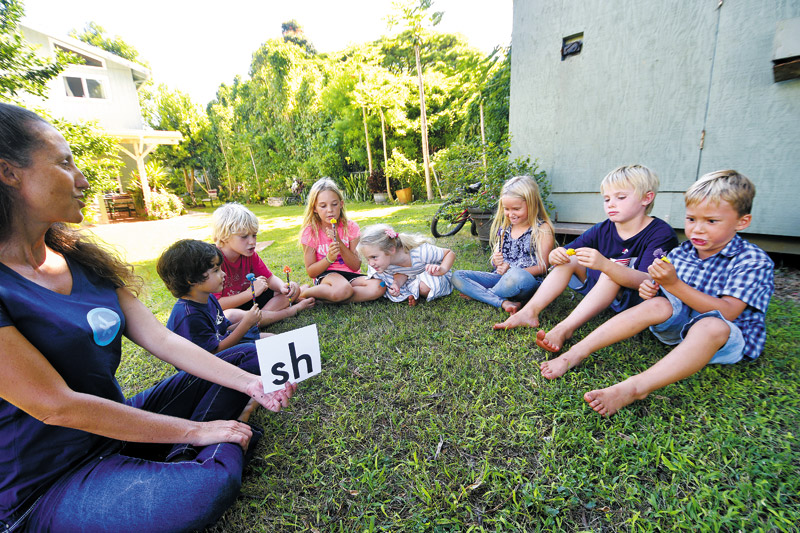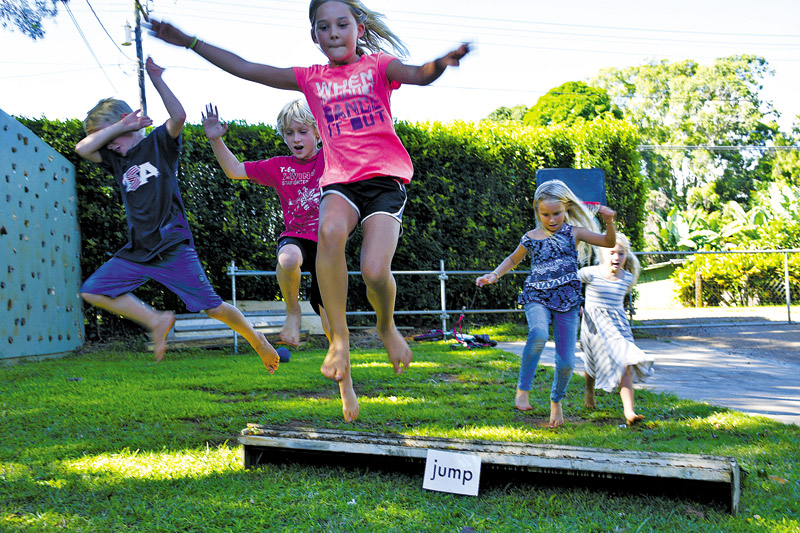Hanging On Her Every Word

Keiki easily learn words through Reading Wave, an innovative curriculum designed to incorporate movement and games into the lessons. Kayana Collins demonstrates the meaning of “upside down” using flashcards with Nash Colburn.
Keiki dash about the home of Angela Kuzma where she operates the Kenyen (the quest for knowledge) Learning Center, a K-8 home school in Kōloa. The kids are eager to learn, but they’re also intent on playing games and interacting with each other. In fact, the desire for young children to want to move and play was so evident to Kuzma early on in her professional teaching career that she was inspired to create an innovative reading curriculum. Instead of combatting fidgety behavior by forcing children to sit still, she uses their innate urge to move, play and socialize, and incorporates it into a new language arts product she developed called Reading Wave.
The curriculum is part of a concept she has used in her classrooms for many years but only recently made available as a full-fledged product to anyone tasked with teaching children ages 3-8 how to read.
“What it does is stimulate the part of the brain that helps them learn to read,” says Kuzma.
The mother of three — Keana, Kason and Kadia — who has served as a teacher for more than two decades, has used all kinds of curriculum to help children learn to read. Yet, she found that none of them contained activities allowing children to get up out of their chairs and take action. She also discovered that the part of the brain that controls movement, the cerebellum, is the same component that learns language.
“And reading is actually a language,” she says.
So, when they squirm, they’re actually inducing the part of the brain that’s attempting to learn. Kuzma, who taught at Kahili Adventist School for 12 years, took that knowledge and her experiences and developed multi-level lessons that allow keiki to progressively learn to read with not only color-coded, illustrated books that tell enjoyable Kaua‘i-themed stories, but with more than 200 “move and play” activities and games, as well as workbooks.
Showing a child the word “jump” on a flash card and then having them simultaneously complete the action, for example, helps them learn how to say the word and also what it means more quickly than if they were simply sitting at a desk.
The product has worked so well with her students that she’s confident parents, tutors, daycare instructors and other teachers would benefit from it. That’s why she teamed up with publisher Jade Moss to make it available to everyone. Together, they launched a Kickstarter campaign, which ends Aug. 30, to help get the one-of-a-kind Reading Wave product into everybody’s hands.
Moss knew she wanted to be involved as soon as Kuzma introduced the idea to her about three years ago. As a mother of a 4-year-old son, Zenao Gonzalez, and a 2-year-old daughter, Teagan Gonzalez, Moss understands the significance of the product.
“I wanted something, too, for my kids,” she says.

Angela Kuzma teaches an activity from her Reading Wave curriculum that helps keiki learn to pronounce letters and sounds by incorporating movement and games into the lessons.
It’s already been a big hit with her son, who frequently wants to use Reading Wave.
“It’s fun to see him actually starting to have that thirst for knowledge,” says Moss, who holds a journalism degree from San Diego State University.
She also resonates with Reading Wave because of her personal struggle learning to read as a child and attempting to ignore it by flying under the radar at school.
“I made deals with my friends so I wouldn’t get called on to read,” she says.
But if there had been a program like this supplementing her work at school, Moss says there’s no doubt she would have raised her hand in class.
The kit contains a total of 26 comprehensive lessons that come with a schedule parents or teachers can use at their own pace. Toys, props and school supplies also are included in the kit, which not only teaches keiki how to make the appropriate sounds of letters in words, but also about word families and even those pesky English words that when enunciated don’t fit the norm.
“We’ve made it as easy as we can,” says Kuzma, who has a master’s degree in curriculum and instruction from La Sierra University, and prior to moving to Kaua‘i, founded a school in Mexico with her husband, Kevin.
The product also is effortless for caregivers and provides them with an opportunity to connect with their children, especially first-time parents who may have forgotten how to interact with keiki.
“This helped me with my son and put us on the same level to play together, just getting back to the same page,” says Moss.
But the most important thing is that it works.
“Every single student I’ve used it with has learned to read,” says Kuzma, who knew ever since she was in elementary school that she wanted to be a teacher.
She loves watching her students’ “lights click on” while using Reading Wave and she’s proud of the work and commitment it took to cultivate the product with Moss.
“We’ve put a lot of time and love into it,” says Moss.
Learn more about the product and the Reading Wave Kickstarter campaign by visiting readingwave.com.





